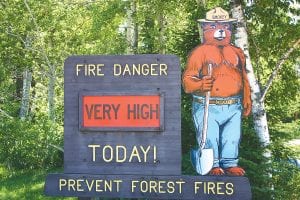Although fire conditions had improved from high to moderate at press time on Thursday, May 16, U.S. Forest Service Fire Management Officer Patty Johnson stressed that things can change quickly. Johnson said the spring season is driven by day-to-day conditions. A day like May 15 with high wind, low relative humidity and high temperatures can greatly increase the fire danger.

Traditionally, most wildfires occur in April and May. More than 95 percent are caused by human error. Because of high fire risk during those months, the Minnesota Department of Natural Resources (DNR) initiates burning restrictions to coincide with the annual “fire season.” Burning restrictions were enacted for Cook County on May 13. Burning permits will not be issued until there is sufficient green vegetative growth.
The restrictions are weather dependent but normally last from four to six weeks. The DNR and the U.S. Forest Service both have issued extreme cautions and the National Weather Service issued a “Red Flag Warning” on Wednesday, May 15.
The Red Flag Warning was issued due to low relative humidity and gusty winds—with no significant rainfall expected. These conditions can contribute to extreme fire behavior, which is happening all around the state. The Green Valley Fire, near Menahga, MN, had burned approximately 7,100 acres at press time, threatening 158 structures, many of them homes. Other fires were burning near Grand Rapids, Red Lake and Sandstone, but seem to be getting under control with cooperation by the DNR, federal agencies and local fire departments.
Across Lake Superior, in Wisconsin, a major wildfire in southern Douglas County was 95 percent contained, but had already done significant damage. The fire destroyed 47 structures, including 17 homes and cabins.
At press time, debris burning was curtailed, however the use of campfires, if smaller than 3 feet in diameter and 3 feet in height, is still allowed.
However, officials stress that fire conditions may change quickly. Extreme fire conditions mean the fire situation is explosive and can result in extensive property damage. Fires start quickly, spread furiously and burn intensely. Very high fire danger means fires start very easily and intensify quickly. High fire danger conditions mean fires start easily and spread at a fast rate.
If conditions warrant, U.S. Forest Service and DNR foresters may restrict campfires on short notice. For more information on fire conditions, see www.dnr.state.mn.us/forestry/fire/firerating_restrictions.html.
Illegal burning is a misdemeanor, but larger financial penalties often result from escaped fires. People can be held personally and financially liable for the costs associated with loss of property, firefighting expenses and cleanup and proper disposal of burnt materials.
Any suspected unauthorized, escaped or illegal fires should be reported by dialing 911. An early report of a fire enables a shorter response time and helps keep fires small.


Loading Comments